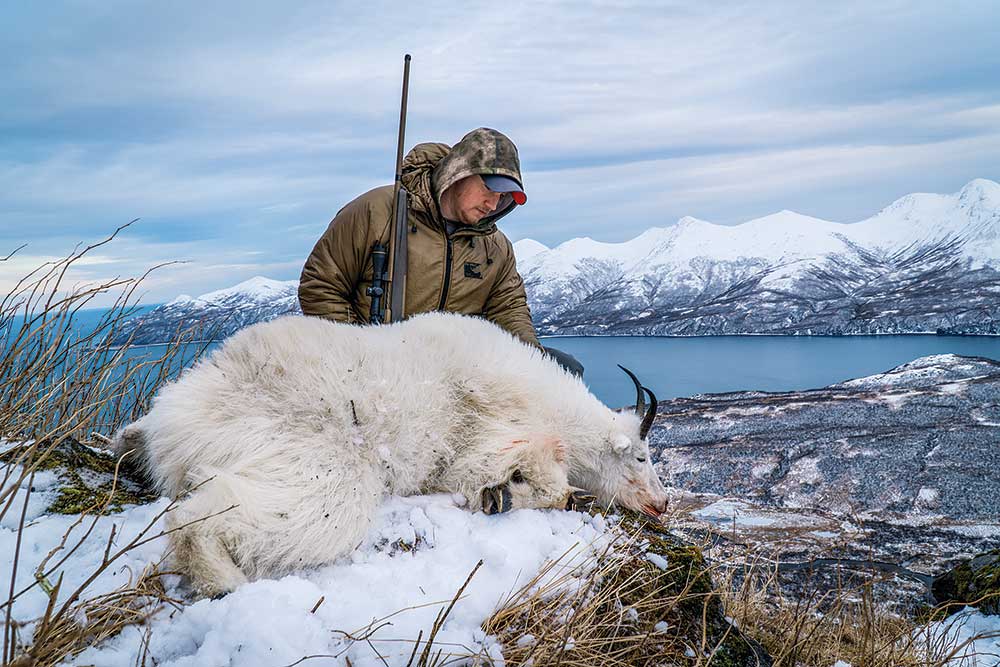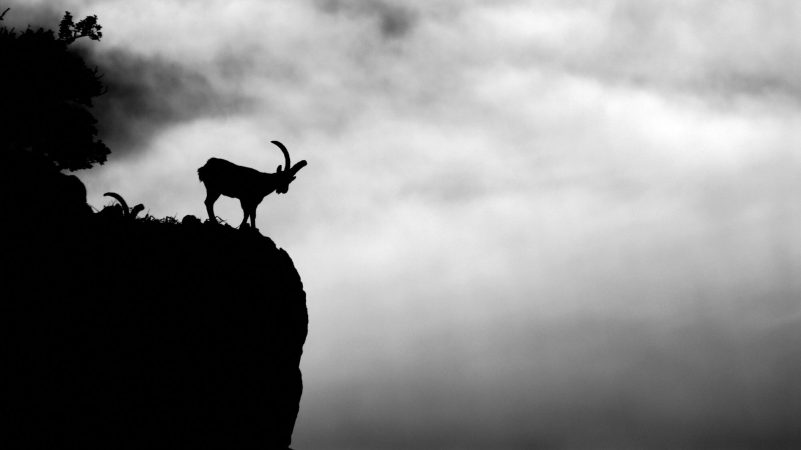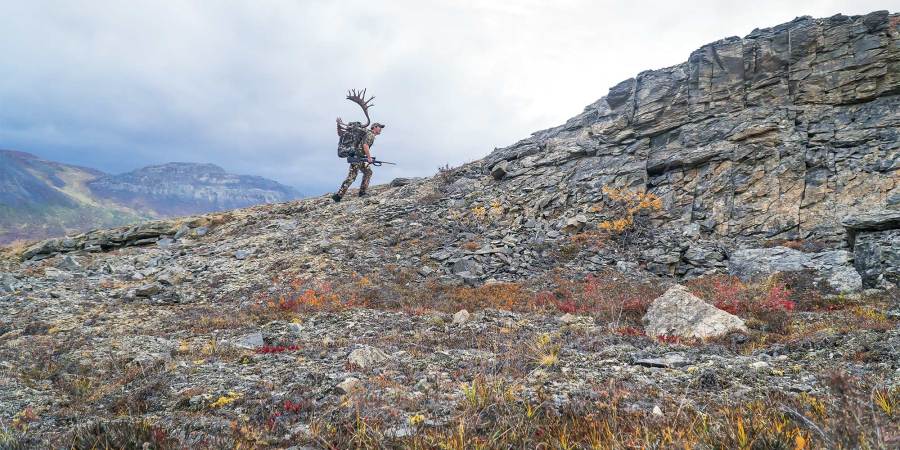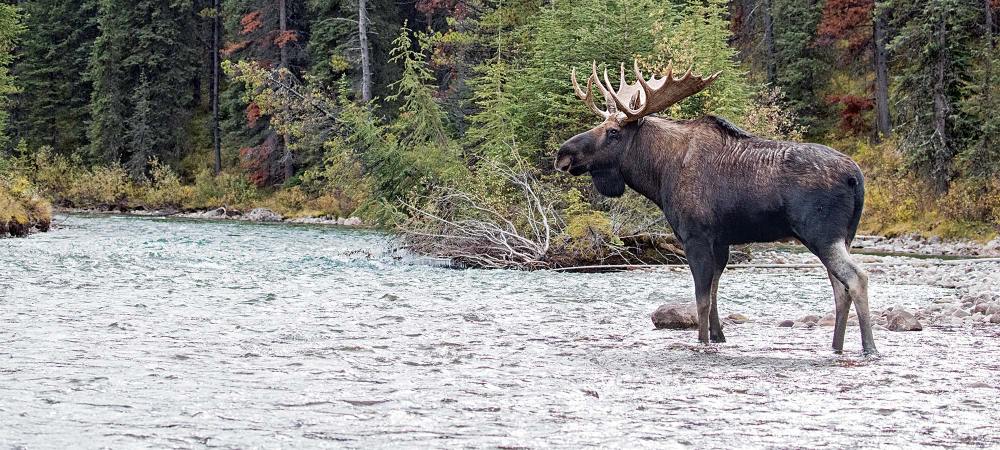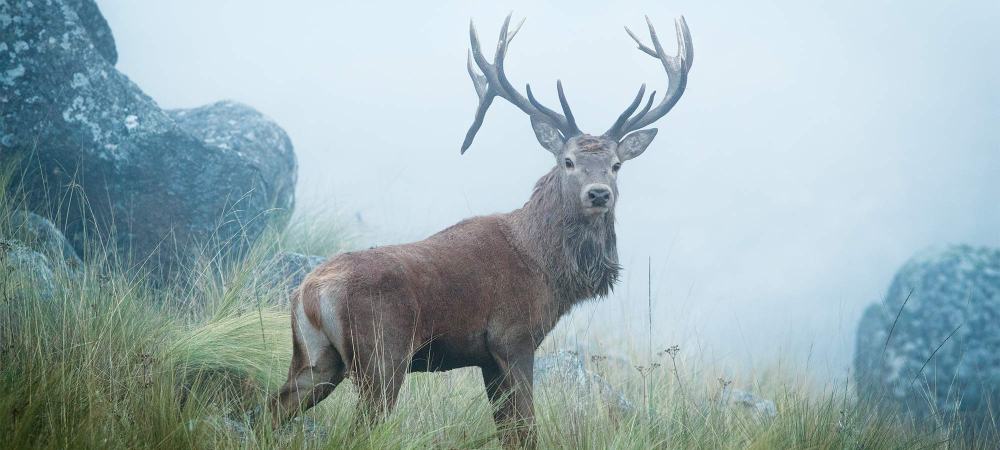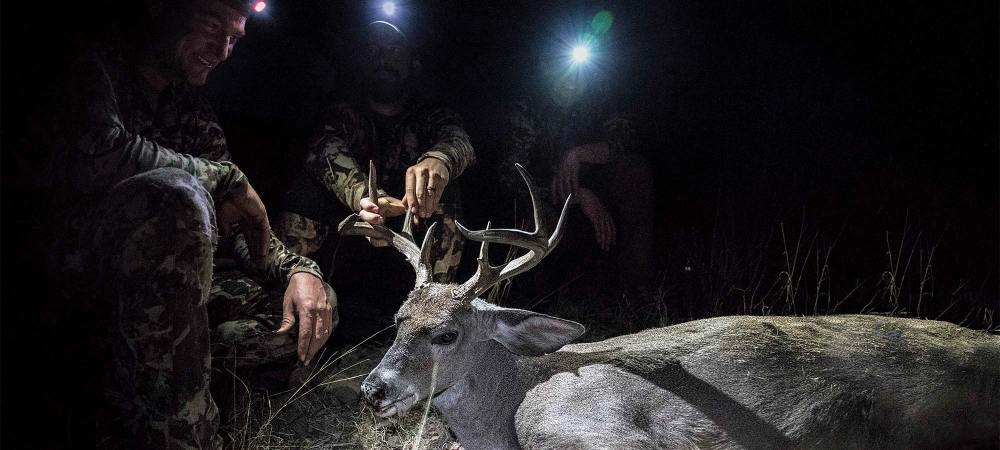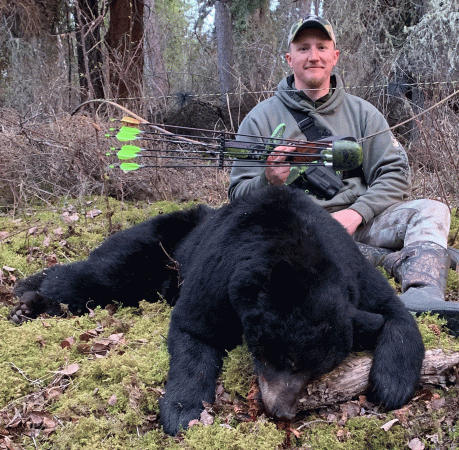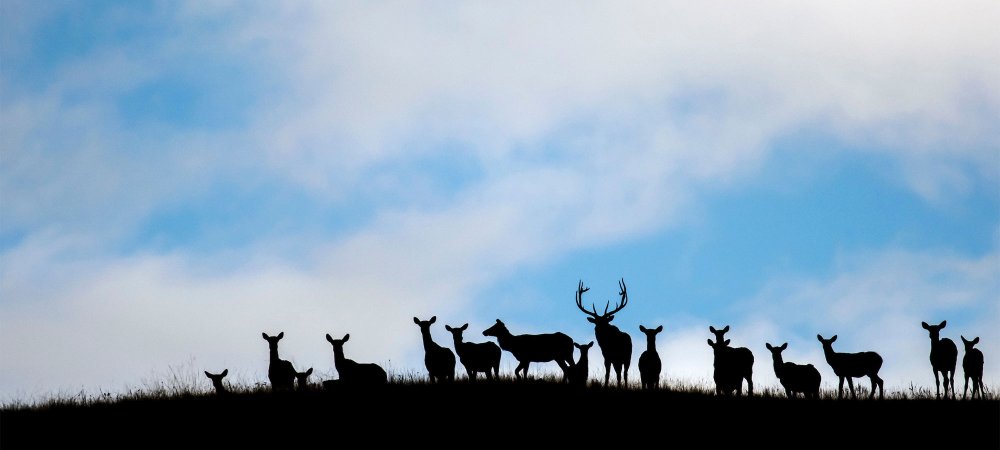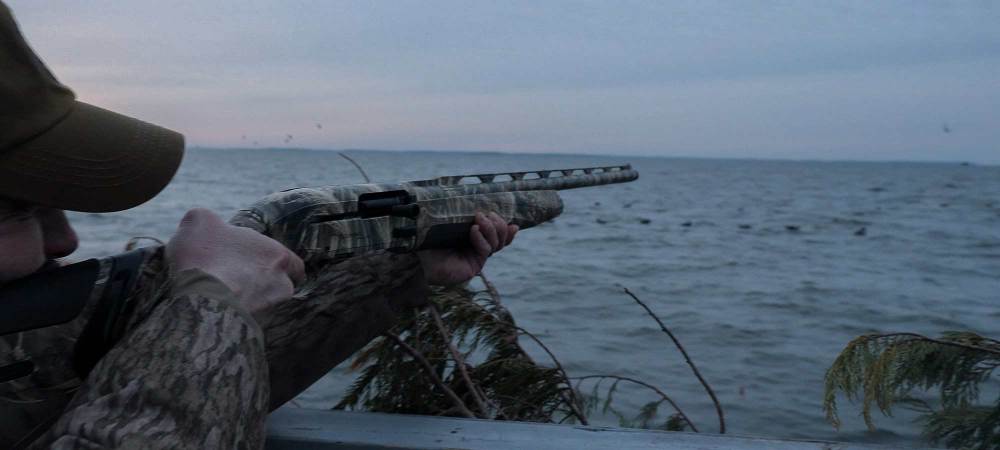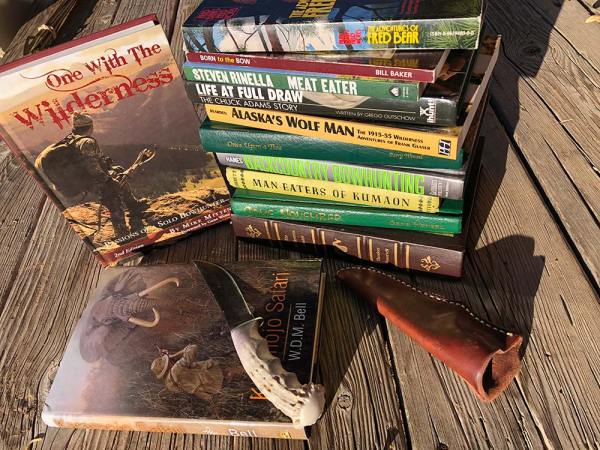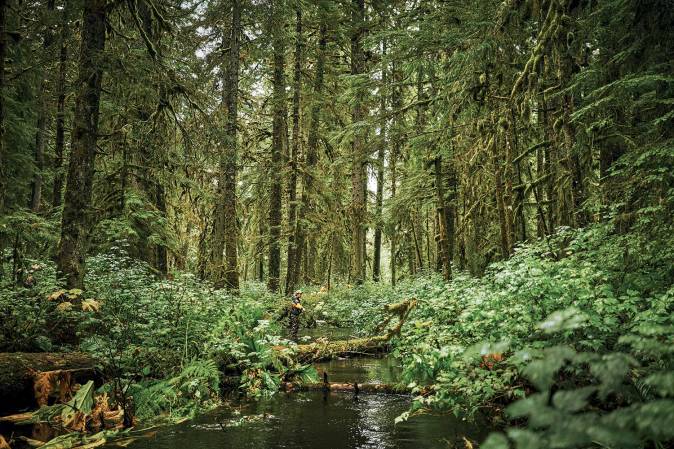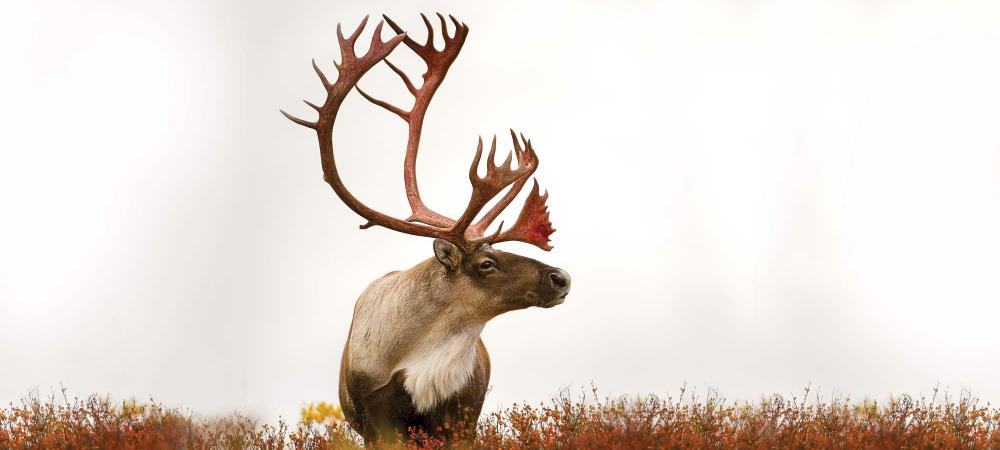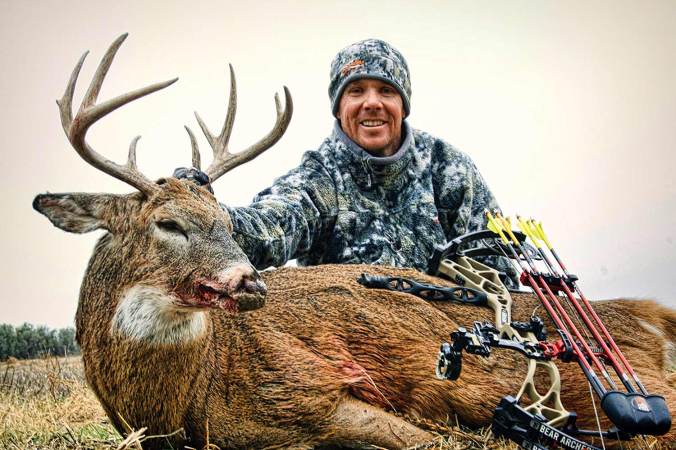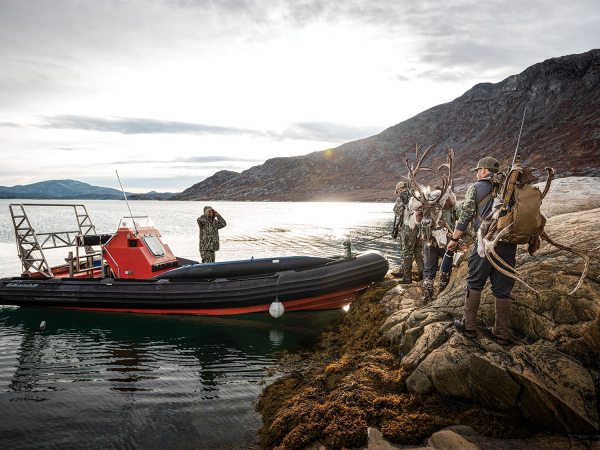We crawled on all fours up a steep, grassy knob—a tiny island in a sea of alders clinging to the mountainside. The crown of this knob was the only place we’d be able to shoot from on the entire slope. A few hours before, we had spotted a group of mountain goats just under the rimrock, some 1,500 feet above the ocean shoreline.
Any stalk on mountain game requires a healthy dose of hope. You use the terrain to block your approach so the animal can’t see you, which means that most of the time, you won’t be able see it either. So, while you hike and climb and crawl, you also hope—that the critter stays put until you sneak into rifle range, or that he moves into the path of your stalk.
So when we reached the top of our knob, I carefully eased the spotting scope up to peek over the grass, hoping to see the goats still feeding on the rock face above.
Goat Heaven and Brown Bear Hell
If there were a single place in Alaska that’s synonymous with adventure, it would be Kodiak. Nowhere else in the Last Frontier can match the lore (both true and exaggerated) that has grown from this chunk of rock. Like, for example, the story of Rodd Moretz, who had killed a bear and hiked past what he thought was an empty den only to be promptly hurled downhill, his head torn open by a single swiping claw. Moretz found his bear, skinned it out, and packed it back to camp before radioing for rescue. Tales of biblical storms, brown bears the size of station wagons that come running to a deer hunter’s gunshots, and alder-choked valleys that end at knife-edge ridges all hang heavy in the air during your bush-plane ride into the island.
And when it comes to mountain goat hunting, Kodiak Island is unparalleled.
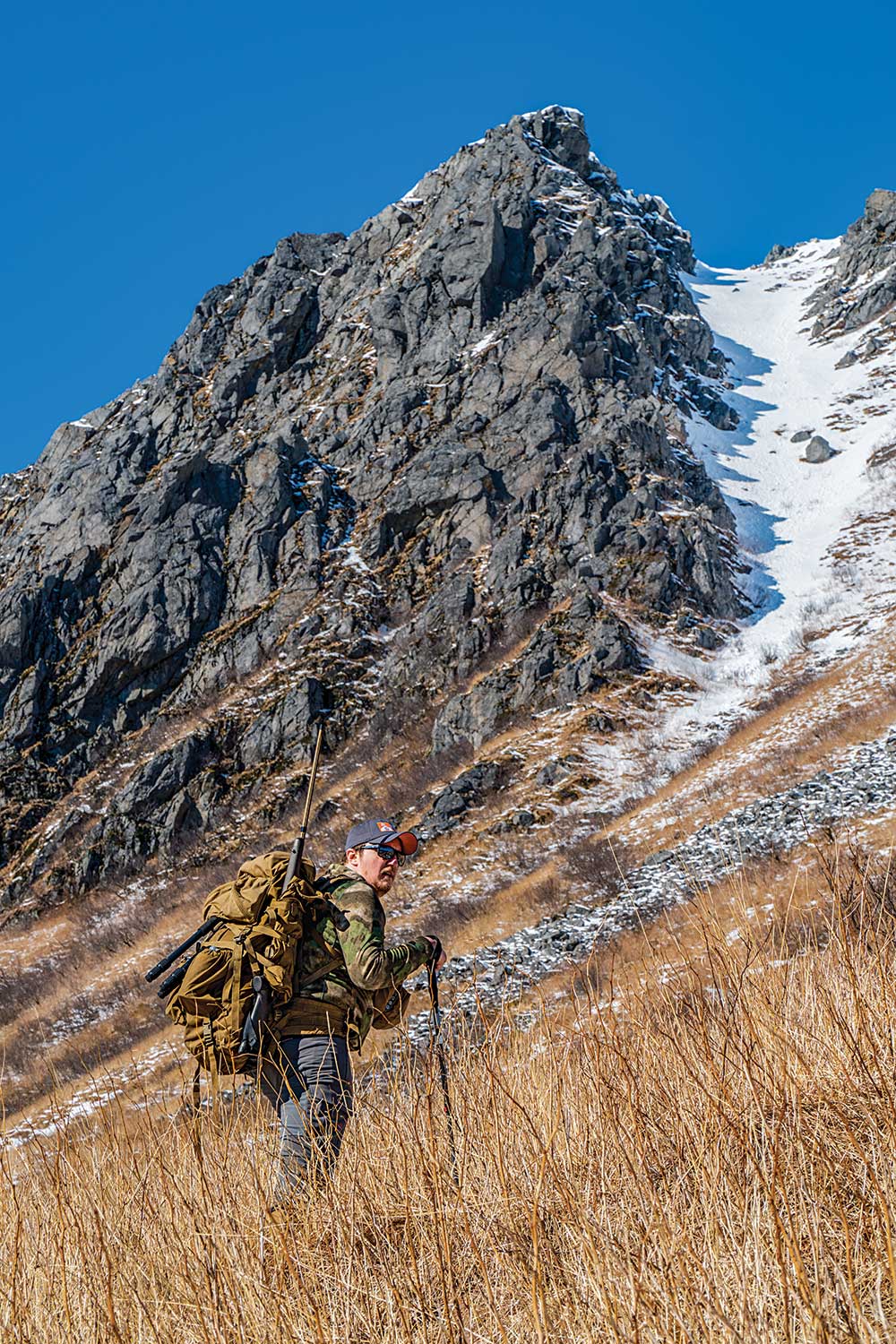
The Rocky Mountain goat, like the Sitka blacktail deer, is not native to Kodiak. The first goats were transplanted here in 1952. Their population has since exploded to cover virtually every yard of suitable habitat on the island. With their success, the new management challenge is keeping their numbers in check. In recent years, regulations for the south end of Kodiak have been adjusted to create what is likely the most opportunity-rich mountain goat hunt in the world. Wildlife managers have opened a seven-month season with a two-goat limit, and they encourage hunters to take nannies in order to meet population goals.
Instead of planning the traditional late-fall goat hunt, fellow Alaskan John Whipple and I decided to make our trip to Kodiak in early March to take advantage of the extended season. At that time of year, winter still has a firm hold on the interior of the island. With all the alpine lakes frozen, our only option was to be dropped off on the beach, or “on the salt,” as any Kodiak pilot would say. After the floatplane dropped us off, we set up camp and climbed a few hundred feet to get a view of the mountains above. Our plan was to spend the afternoon skirting the broken cliffs and to locate goats for the following day. In Alaska, you cannot hunt the same day you fly, so this would strictly be a scouting mission.
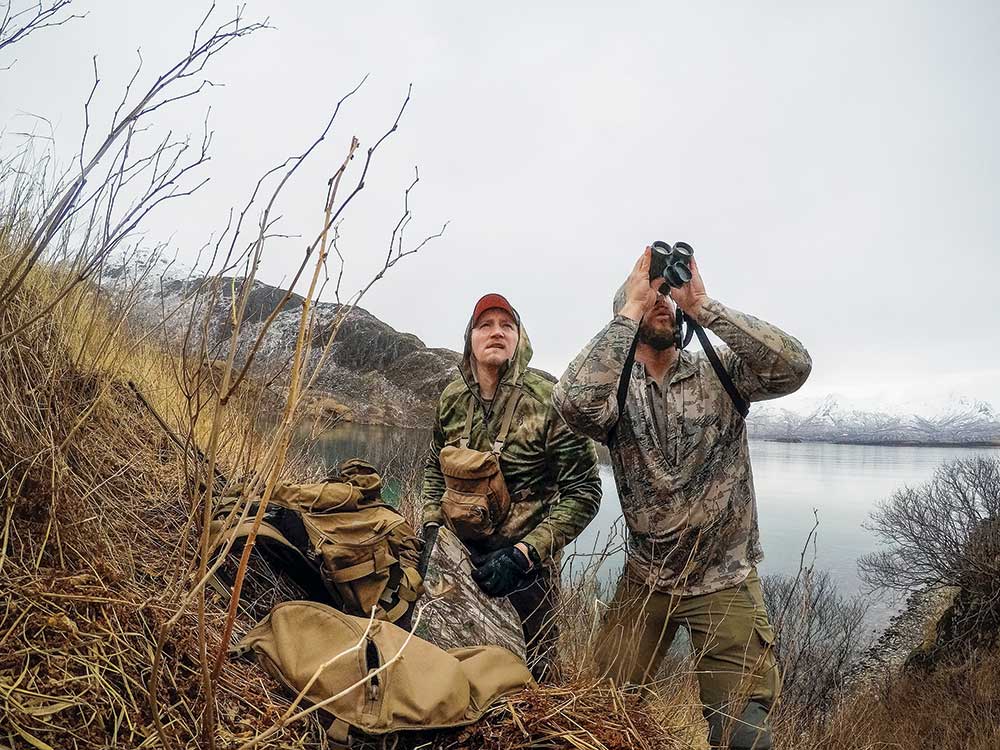
Goats can be tricky to spot in the broken, patchy snow we were glassing. They appear out of nowhere on the same hillside that you had been glassing for an hour. So, we took our time. We were about to cross a brushy rock chute when an agitated cry caught my attention from the alders. Just as I realized it was a brown bear cub only 30 yards away, I heard crashing and then the distinct huffing of an aggravated sow.
She was slightly downhill of us, and the wind was blowing directly in our faces. Tall brush blocked our view. At first, I expected her to charge directly at us, but thankfully she didn’t. We prepared for her to circle us to catch our wind, but she didn’t do that either. We waited, rifle ready, and then spotted the sow and cub on a rock outcropping above, looking down with discontent.
Despite our bear troubles, we were still able to locate a few goats and formulate a plan for the morning.
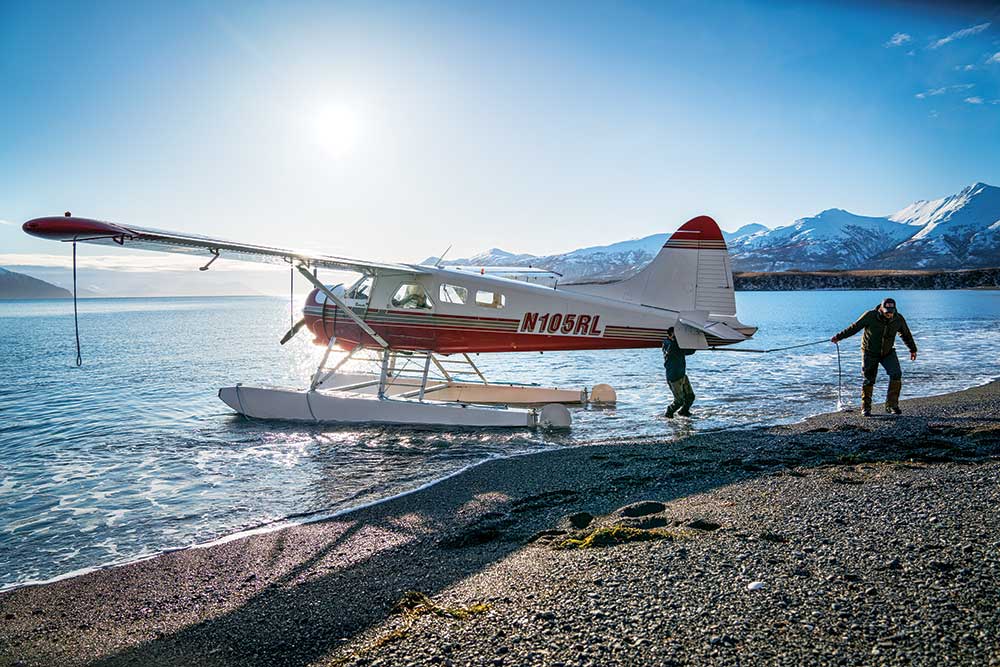
The Climb
The biggest challenge in most mountain goat hunts is finding the right goat in the right spot. Locating one is easy enough, but then you need to be able to climb within shooting range. Most importantly, you must be able to safely retrieve the goat after you’ve killed it. A slip in goat country could wreck your hunt, or much worse.
And once they are hit, goats are notorious for using their last bit of energy to launch themselves off the nearest cliff. An old billy spends his whole life clinging to a steep rock face and then uses his last few seconds to throw himself off it.
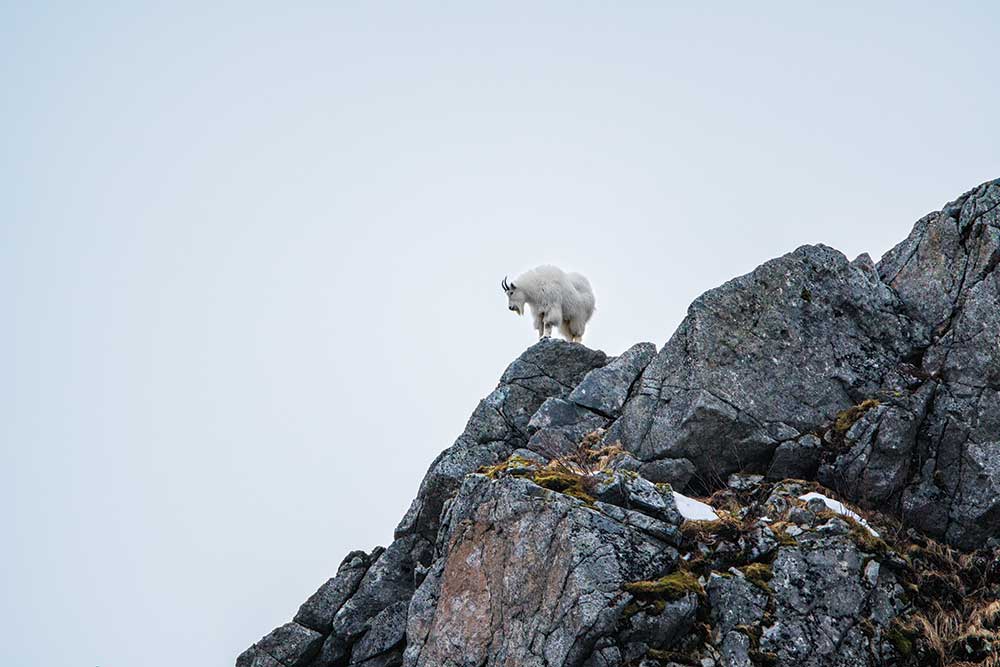
On that first day of scouting, we noticed that the goats spent all morning up in their high mountain fortresses, where it would be impossible to responsibly shoot one. So we decided to wait until they made their way down from the cliffs in the afternoon to feed. We slept in, had a good breakfast, and headed out of camp late.
Mountain goats are fascinating critters. They are among the most majestic animals in Alaska, and the terrain in which they live only adds to that majesty. They can travel with ease where no human can follow (at least, not without climbing gear), and they would be all but invincible to a hunter’s efforts if it were not for one character flaw: They are gluttonous. Goats like the very best feed. Most of the time, there is plenty for them to live on in the high country where they spend most of their time, but the lushest plants grow lower on the mountain and are too tempting for goats to resist.
By midafternoon we were glassing intently, and right on schedule goats started appearing out of the cliffs, working their way down the mountain to feed. We singled out a group about 800 yards away and planned a stalk. Staying out of sight wouldn’t be a problem thanks to the wall of alders and salmonberry brush between us, but that cover was a double-edged sword. Where could we shoot from? I spotted one grassy spine, just above a dry creek chute, about 300 yards from the goats. We decided to go for it.
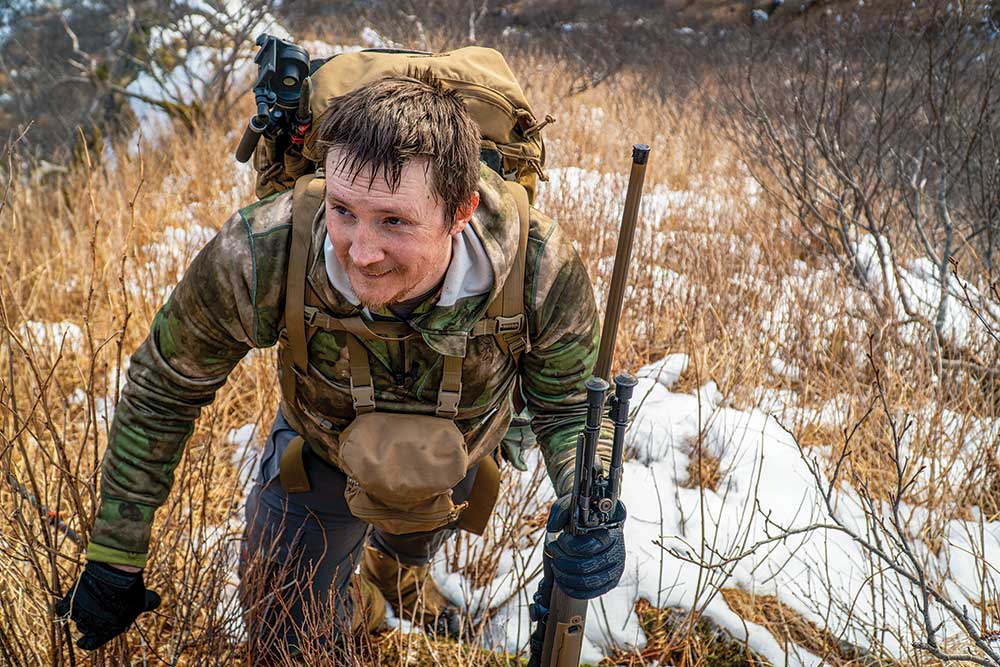
It took us more than an hour to reach that one grassy outpost, climbing through thick cover most of the way and then belly-crawling to the top. Through the spotting scope, I found the goat we were after—a mature, lone nanny. I settled in behind the rifle. As the goat paused in a ravine between cliffs, I squeezed and dropped the old nanny where she stood. But true to her kind, with one last effort, she reared up on her hind legs and slid 100 yards downhill before coming to a stop.
I figured it would take us about 30 minutes to climb up to the goat, but an hour into it, we had covered only half the distance. Every step was a battle. If it had been just the brush, the snow, or the steep hillside, it would have been short work, but combined, it felt like the mountain itself was trying to keep us out. From a distance, salmonberry brush looks almost easy to pass through. However, when you get close, you realize that this sinister plant grows just high enough to slap you in the face with each stride. Another of its dirty tricks is to provide just enough resistance to push you away from the hillside while you try to climb through, but not enough strength to let you use it as a handhold to pull yourself up. Throw in a few sharp thorns, plus crotch-deep snow in every gully, and you’ve got yourself a party.
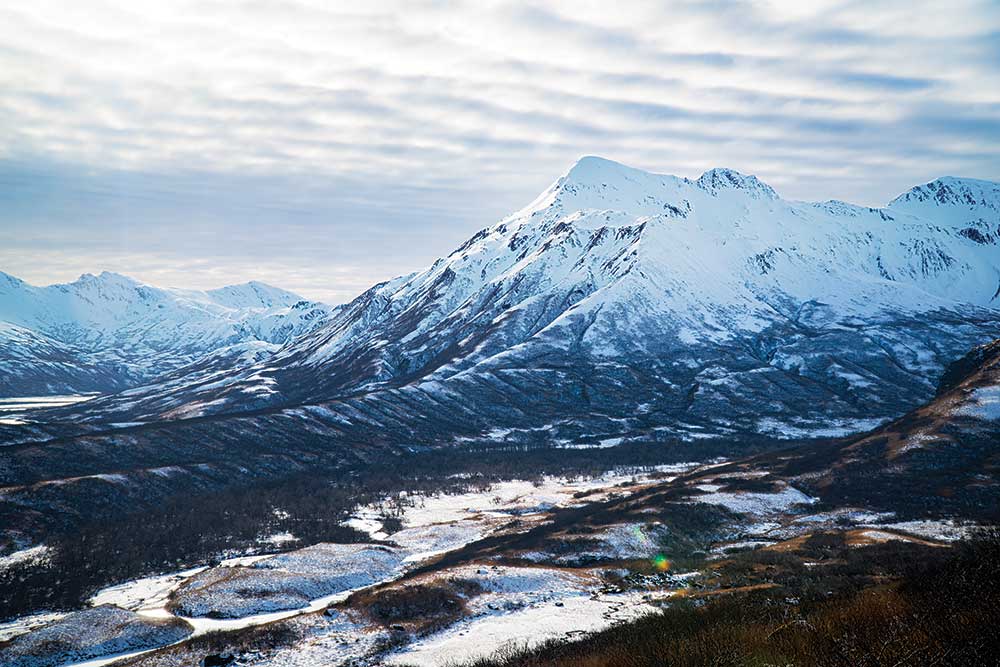
After more than two hours of this, we made it to the goat, which was suspended in midair on an outstretched alder, over a nearly vertical cut in the mountainside. With some effort, and a little luck, we pulled the goat from its perch and swung it across the hillside while we hung from the alder branches. We were able to slide the goat over to a patch of flat ground about the size of a coffee table, and from there we could break it down safely.
It was nightfall by the time we finished quartering the goat, and we did our best to pick a route down to camp. But there was no obvious path, and we ended up just barreling in the general direction of “down.” We passed the area where we’d jumped the bears the day before, crashing through plenty of brush along the way. The thick vegetation formed an illuminated wicker curtain in our headlamp beams, right in front of our faces. I managed to fall only once and was quickly snatched up by the brush—as if the mountainside was trying to claim me for good. We finally walked into camp well after midnight, exhausted but with the deep feeling of satisfaction that comes with an honest effort, and fresh meat.
A Walk on the Beach
The following day we were socked in with rain and low visibility (so, pretty normal weather on Kodiak). We didn’t complain much about the rest that was forced upon us, but we were anxious to get back at it the following day.
After the weather broke, we decided to work our way along the shoreline, glassing the mountain cliffs, which dropped abruptly into alders and then to the ocean. We had been seeing more and more goats on that side of the mountain and figured we would get a crack at one as they descended into the brush to feed.
Soon enough, we spotted another tribe of goats that had descended into a series of broken alders and berry brush. But they were still too high to shoot from the beach. We could try to gain elevation, but then we would be too engulfed in brush to get a clear vantage. So we watched and waited, and eventually the goats headed onto an outcropping above a knob.
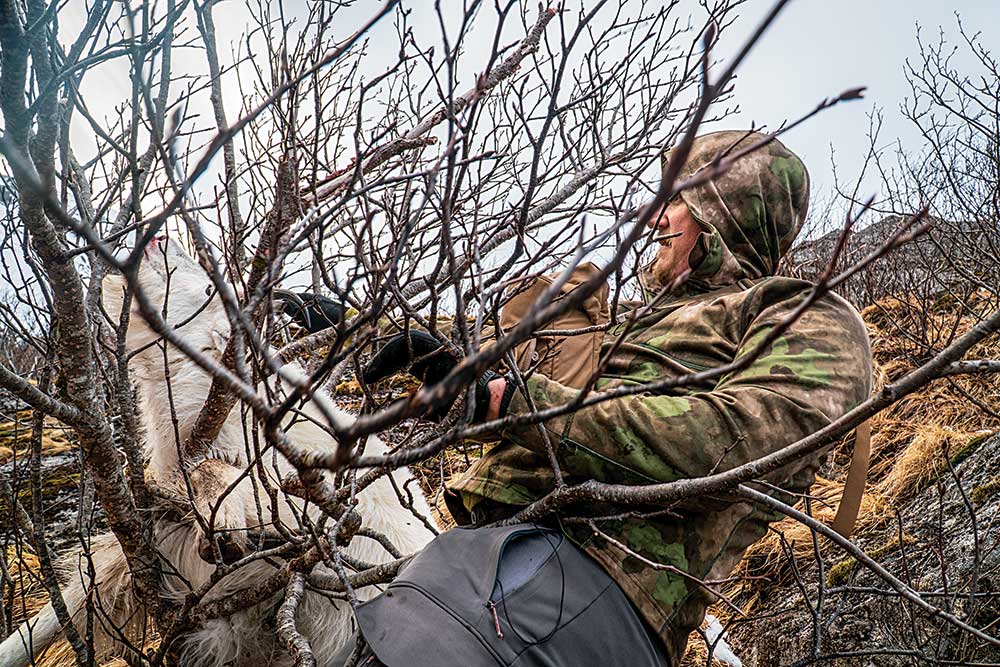
We skirted the high tide, climbing through the wet boulders along the beach at the edge of the alder jungle. While boulder hopping, I slipped forward and smashed my chest squarely onto a rock (which was mercifully flat). In the fall, I managed to bash my finger and ding up my binoculars. I considered both a small price to pay for hunting Kodiak, and we continued hustling up after the goats.
We climbed up the hill and set up under an alder, with the goats still in view. We waited for the goat we wanted to turn broadside, and John sent the old nanny rolling downhill.
Now we both had our mountain goats, plus the scratches, cuts, bruises, and aching muscles that it took to get them.
Loading the last bags of meat into our packs was bittersweet, just as the end of any good adventure always is. We shouldered our packs and headed back down to camp. The forecast was calling for more storms on the mountain.
Read Next: Tips and Tactics for Hunting Mountain Goats
A Rifle for Kodiak
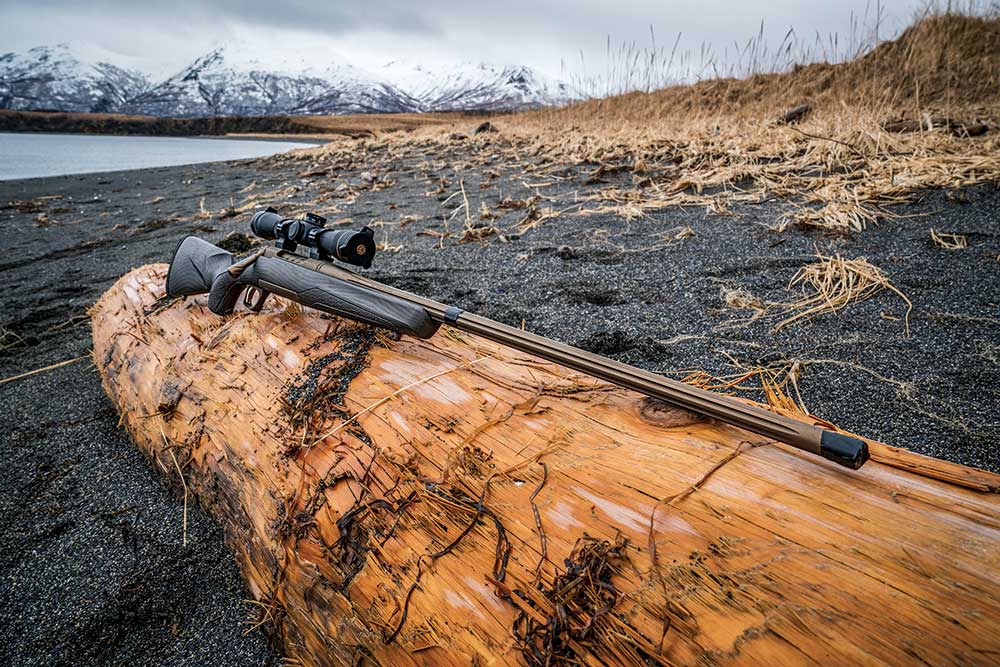
I carried the Browning X-Bolt Pro in .300 Win. Mag. I wanted a hard-hitting caliber because goats are notoriously tough critters to put down, plus there was the possibility of having to shoot a charging brown bear on this hunt. The rifle itself is built to withstand the island’s brutal environment. It’s streamlined, accurate, and even lighter than previous X-Bolts thanks to its carbon-fiber stock. It handled with the finesse of a mountain rifle but still took a beating and withstood the wet Kodiak weather like a champ.

